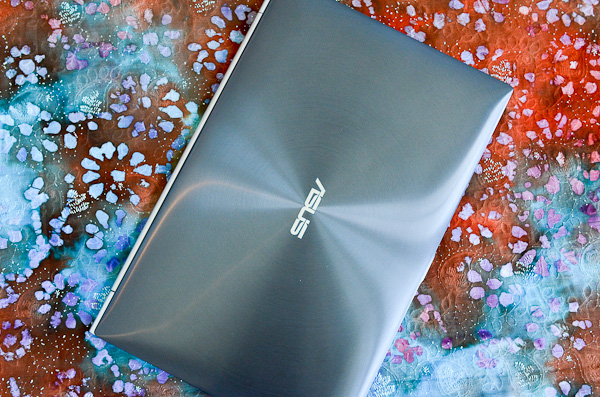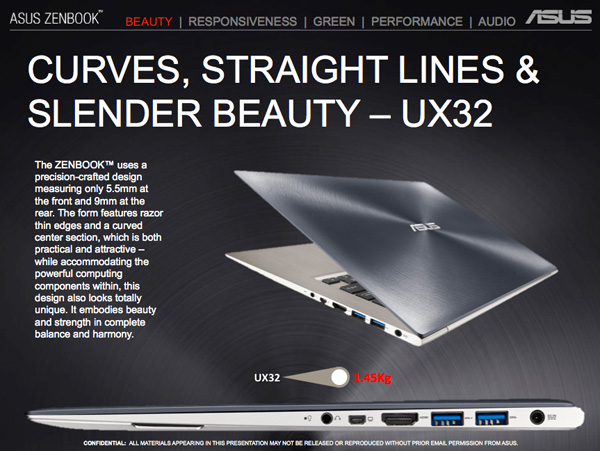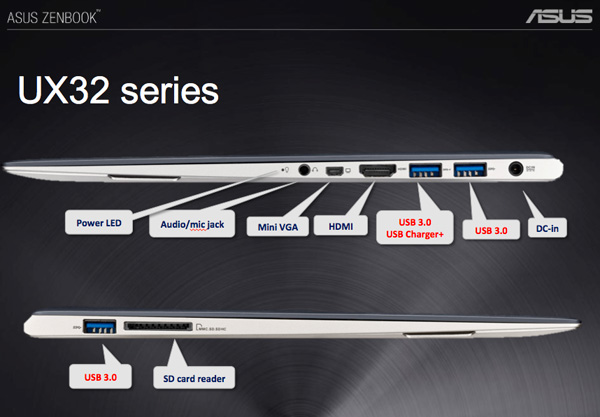ASUS Zenbook Prime (UX21A) Review: The First of the 2nd Gen Ultrabooks
by Anand Lal Shimpi on May 22, 2012 2:46 PM EST- Posted in
- Laptops
- CPUs
- Asus
- Ivy Bridge
- Zenbook
- Zenbook Prime
- Ultrabook
- Notebooks
The first round of Ultrabooks were mostly underwhelming. It shouldn't be a surprise, but many of the efforts were just half hearted at best. Of the companies who shipped the first Ultrabooks however, it was ASUS who came the closest to perfection with the Zenbook.
ASUS' Zenbook embodied the form factor, portability and overall concept of an Ultrabook. Where it failed to deliver was with its keyboard, display and, at least initially, with its trackpad. The first Zenbook was an amazing effort given the short period of time that it was conceived and developed in, but it was too rough around the edges.
Despite only being introduced 7 months ago, the Zenbook is old news. This is the Zenbook Prime:
The Zenbook Prime is ASUS' second generation Ultrabook, built around Ivy Bridge silicon. Unlike most silicon updates to notebooks however, the Zenbook Prime takes an almost Apple-like approach to renovating the tangibles rather than just relying on a faster chip to do the heavy lifting.
I don't know that I've ever seen a faster turn around on implementing reviewer and user feedback into a product. The Zenbook Prime fixes nearly every issue I had with the original Zenbook. From keyboard to display, it's all significantly better with the Zenbook Prime.
The circumstances around today's launch are a bit peculiar. Intel has an embargo in place on the as of yet unreleased Ivy Bridge CPUs, this applies to both notebooks and desktops. One such line of CPUs, the dual-core ultra-low-voltage Ivy Bridge parts that will find their way into many Ultrabooks, is covered by the aforementioned embargo. That embargo lifts at some point in the not too distant future, but ASUS wanted to have its review-ready hardware out the door and getting coverage before then. Why the urgency? It could have something to do with Apple's expected launch of updated MacBook Air and MacBook Pro systems. Rather than for Apple to get all the glory for being first, ASUS set some guidelines: we're allowed to talk about everything to do with the new Zenbook Primes, we just can't get into specifics on the CPU just yet. That's right, you won't read any model numbers, clock speeds or cache sizes here. Given what's already public about the ULV Ivy Bridge lineup I suspect this information isn't too hard to figure out if you're really motivated.

Zenbook Prime (left) vs. Zenbook (right)
The rest of the Zenbook Prime has nothing to do with Ivy Bridge. The form factor of the Zenbook Prime remains unchanged from its predecessor. Just like before we'll see two distinct models, an 11-inch (UX21) and 13-inch (UX31) in for review. With the lid closed, these two look identical to their Prime-less (composite numbered?) counterparts. ASUS sent the 11-inch Zenbook Prime in for review:
| ASUS Zenbook Prime Specs | |||||||||
| UX21A-DB5x | UX21A-DB7x | UX31A-DB51 | UX31A-DB52 | UX31A-DB71 | UX31A-DB72 | ||||
| CPU | ULV IVB | ULV IVB | ULV IVB | ULV IVB | ULV IVB | ULV IVB | |||
| GPU | HD 4000 | ||||||||
| Display | 11.6-inch 1920 x 1080 IPS | 13.3-inch 1920 x 1080 IPS | |||||||
| Memory | 4GB DDR3-1600 (on-board) | ||||||||
| Storage | 128GB U100 SSD | 128/256GB U100 SSD | 128GB U100 SSD | 256GB U100 SSD | |||||
| Wireless Connectivity | Intel Centrino N 6205, 802.11b/g/n 2.4/5GHz 2x2:2, Bluetooth 4.0 | ||||||||
| Battery | 35Wh | 50Wh | |||||||
| Camera | 720p front facing | ||||||||
| Audio | Bang and Olufsen ICEpower | ||||||||
| I/O | 2 x USB 3, 1x audio/mic, 1x microHDMI, 1x miniVGA | 2 x USB 3, 1 x audio/mic, 1 x microHDMI, 1 x miniVGA, 1 x SD Card reader | |||||||
| Dimensions | 299mm x 168.5mm x 3-9mm | 325mm x 223mm x 3-9mm | |||||||
| Weight | 1.1kg | 1.3kg | |||||||
| Price USD | TBD | TBD | $1099 | $1199 | $1499 | $1599 | |||
Pricing is still in the air as the Zenbook Prime won't be shipping until early June. I suspect much of how aggressive ASUS is on this front will depend on what Apple does in the coming weeks.
Introducing the UX32, Starting at $799
There's also a new member of the Zenbook Prime lineup, the 13-inch UX32. Featuring a thicker chassis, the UX32 will be offered as low as $799 with a 1366 x 768 TN panel, hard drive + SSD cache and as high as $1299 with a discrete NVIDIA GeForce GT 620M GPU:
| ASUS Zenbook Prime UX32 Specs | |||||||||
| UX32A-DB31 | UX32A-DB51 | UX32VD-DB71 | |||||||
| CPU | ULV IVB | ULV IVB | ULV IVB | ||||||
| GPU | HD 4000 | NVIDIA 620M + HD 4000 | |||||||
| Display | 13.3-inch 1366 x 768 TN | 13.3-inch 1920 x 1080 IPS | |||||||
| Memory | 2GB DDR3-1600 (on-board) + 2GB or 4GB SO-DIMM | ||||||||
| Storage | 7mm 320GB HDD + 24GB SSD (cache) | 7mm 500GB HDD + 24GB SSD (cache) | 7mm 500GB HDD + 24GB SSD (cache) | ||||||
| Wireless Connectivity | Intel Centrino N 6205, 802.11b/g/n 2.4/5GHz 2x2:2, Bluetooth 4.0 | ||||||||
| Battery | 48Wh | ||||||||
| Camera | 720p front facing | ||||||||
| Audio | Bang and Olufsen ICEpower | ||||||||
| I/O | 3 x USB 3, 1 x audio/mic, 1 x HDMI, 1 x miniVGA, 1 x SD card reader | ||||||||
| Dimensions | 325mm x 223mm x 5.5 - ~9mm | ||||||||
| Weight | 1.44kg | ||||||||
| Price USD | $799 | $999 | $1299 | ||||||
Depending on how well the SSD cache works, and how good the 1366 x 768 panel is, the $799 UX32A could be a very compelling system.













192 Comments
View All Comments
rast20 - Tuesday, May 22, 2012 - link
Different IVB CPU. We can't see it (both configs only feature "ULV IVB") because it's still supposed to be secret, but I'd guess one is i5 and the other is i7.AmdInside - Wednesday, May 23, 2012 - link
The fact that it features an IPS display makes it an easy choice over a Macbook Air and I personally love both Win7 and MacOSX so it is not about OS. I wish I had not just purchased a projector or else this would be on my shopping list right now.ImSpartacus - Wednesday, May 23, 2012 - link
Over a 2011 Macbook Air, sure.I'm reserving judgment until I see the 2012 models. As Anand mentioned, ASUS wouldn't've rushed the Zenbook Prime review units if they didn't have to do it. We won't be waiting long.
cwcwfpfp - Wednesday, May 23, 2012 - link
Thanks for the thorough and insightful preview Anand. By far the most informative of all the previews/hands-ons for the UX21A I've read.I am going to add my voice to those pointing out the 4GB limit. While I think those saying 4GB won't be enough for gaming are a being unrealistic, I do think it is realistic to want more RAM options for other reasons. Right now 4GB should be just fine, but do you guys really see it being sufficient 2 years down the line? I say this as a graduate student often on the move who would like something light to carry around and do work on. So I do foresee having multiple applications running at once and would love more RAM for future-proofing.
I also have my own issues with the keyboard and touchpad layout - basically I think they went too far in borrowing elements of the MacBook Air here and suffer from form over function. Not a fan at all of the clickable touchpad - much prefer dedicated left/right buttons (and even additional buttons above the touchpad would be nice). Also would like to see dedicated page up/down keys - preferably right above the arrow keys. This is more of a personal preference though. I'm sure a fair number of people will disagree with me on that.
That said, overall the UX31A/21A looks like the ultrabook to beat right now. In fact I will likely pick up a UX31A when it comes out, despite my minor complaints above.
SignalPST - Wednesday, May 23, 2012 - link
Can you test the WiDi feature on the Prime? I've heard that version 2.0 supports 2 individual display outputs at 30fps or 1 output at 60fps.Also, since IVB supports max 3 display outputs, can you output both to the microHDMI and miniVGA, and keep the main LCD active as well?
IntelUser2000 - Wednesday, May 23, 2012 - link
I think that's with WiDi 3.0, which will likely come with updated HD Graphics drivers. WiDi 2.0 didn't come with Sandy Bridge launch, only with updated drivers.Also it says on one Ivy Bridge presentation that you can output to two additional monitors using HDMI and Displayport.
SignalPST - Thursday, May 24, 2012 - link
Hmm... you're right. Hopefully we'll get to see some of that action on the Prime.ssj4Gogeta - Wednesday, May 23, 2012 - link
"life is short, I draw the line at spending it testing claims of 150 day standby battery life"You forgot you' have to measure it three times then take the average. :-P
Pantsu - Wednesday, May 23, 2012 - link
Hopefully the 13" models won't be overpriced where I live, since this could be my next laptop. I was afraid the 1080p panel would be only available for $1500+ models.The W7 scaling is probably why most laptop manufacturers didn't want to offer 1080p option. Luckily Windows 8 should fix that issue too.
I'm still debating though whether I want an ultrabook or if I could do with a standard voltage model with discrete graphics, as long as it is lighter than my current white macbook. I don't need an optical drive or ethernet, but neither do I necessarily need the laptop to be ultra thin and light. Looks like I'll wait until back-to-school season until I make my pick though. There should be a good amount of choices available then.
ijozic - Wednesday, May 23, 2012 - link
I don't understand why Asus designs their Zenbooks pretty much like MB Airs? Personally, I find the Apple laptops' looks overly sterile so this makes the Zenbook a no choice for me (unfortunately).My biggest functional gripe with this choice is that they are copying the side profile design of the case - IMHO, if they'd made a case with a uniform thickness, they'd have had room for more ports (e.g. more USBs, SD card reader slot, maybe even a thin express card slot), plus extra battery capacity.
Also, a 1600x900 screen would seem as a more usable choice and thus it would be nice to have it as an option. Well, at least the screens are not glossy as on the Apple..